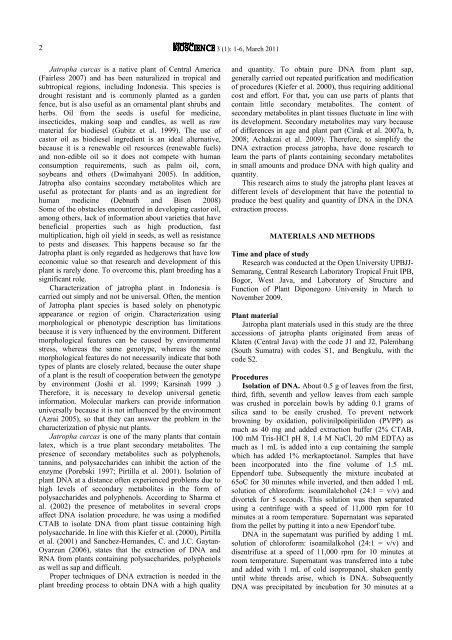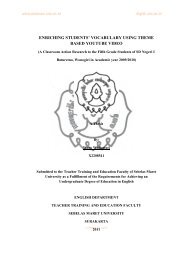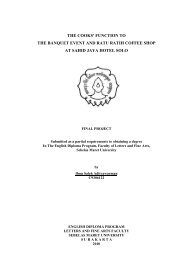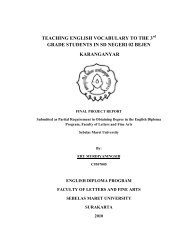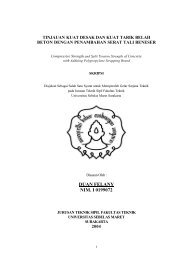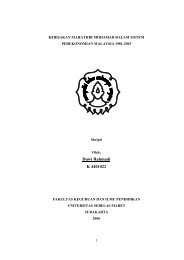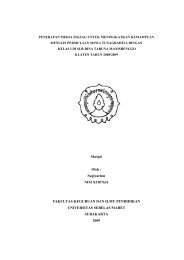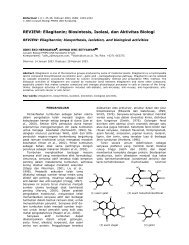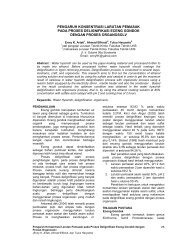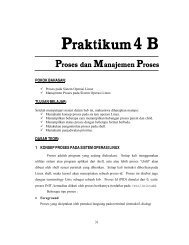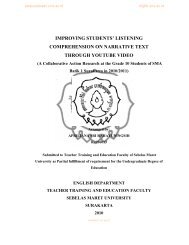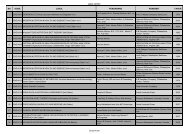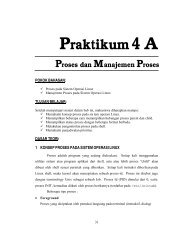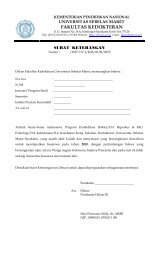ISSN 2087-3940 (PRINT) | ISSN 2087-3956 ... - Biodiversitas
ISSN 2087-3940 (PRINT) | ISSN 2087-3956 ... - Biodiversitas
ISSN 2087-3940 (PRINT) | ISSN 2087-3956 ... - Biodiversitas
You also want an ePaper? Increase the reach of your titles
YUMPU automatically turns print PDFs into web optimized ePapers that Google loves.
2<br />
3 (1): 1-6, March 2011<br />
Jatropha curcas is a native plant of Central America<br />
(Fairless 2007) and has been naturalized in tropical and<br />
subtropical regions, including Indonesia. This species is<br />
drought resistant and is commonly planted as a garden<br />
fence, but is also useful as an ornamental plant shrubs and<br />
herbs. Oil from the seeds is useful for medicine,<br />
insecticides, making soap and candles, as well as raw<br />
material for biodiesel (Gubitz et al. 1999). The use of<br />
castor oil as biodiesel ingredient is an ideal alternative,<br />
because it is a renewable oil resources (renewable fuels)<br />
and non-edible oil so it does not compete with human<br />
consumption requirements, such as palm oil, corn,<br />
soybeans and others (Dwimahyani 2005). In addition,<br />
Jatropha also contains secondary metabolites which are<br />
useful as protectant for plants and as an ingredient for<br />
human medicine (Debnath and Bisen 2008)<br />
Some of the obstacles encountered in developing castor oil,<br />
among others, lack of information about varieties that have<br />
beneficial properties such as high production, fast<br />
multiplication, high oil yield in seeds, as well as resistance<br />
to pests and diseases. This happens because so far the<br />
Jatropha plant is only regarded as hedgerows that have low<br />
economic value so that research and development of this<br />
plant is rarely done. To overcome this, plant breeding has a<br />
significant role.<br />
Characterization of jatropha plant in Indonesia is<br />
carried out simply and not be universal. Often, the mention<br />
of Jatropha plant species is based solely on phenotypic<br />
appearance or region of origin. Characterization using<br />
morphological or phenotypic description has limitations<br />
because it is very influenced by the environment. Different<br />
morphological features can be caused by environmental<br />
stress, whereas the same genotype, whereas the same<br />
morphological features do not necessarily indicate that both<br />
types of plants are closely related, because the outer shape<br />
of a plant is the result of cooperation between the genotype<br />
by environment (Joshi et al. 1999; Karsinah 1999 .)<br />
Therefore, it is necessary to develop universal genetic<br />
information. Molecular markers can provide information<br />
universally because it is not influenced by the environment<br />
(Azrai 2005), so that they can answer the problem in the<br />
characterization of physic nut plants.<br />
Jatropha curcas is one of the many plants that contain<br />
latex, which is a true plant secondary metabolites. The<br />
presence of secondary metabolites such as polyphenols,<br />
tannins, and polysaccharides can inhibit the action of the<br />
enzyme (Porebski 1997; Pirtilla et al. 2001). Isolation of<br />
plant DNA at a distance often experienced problems due to<br />
high levels of secondary metabolites in the form of<br />
polysaccharides and polyphenols. According to Sharma et<br />
al. (2002) the presence of metabolites in several crops<br />
affect DNA isolation procedure, he was using a modified<br />
CTAB to isolate DNA from plant tissue containing high<br />
polysaccharide. In line with this Kiefer et al. (2000), Pirtilla<br />
et al. (2001) and Sanchez-Hernandes, C. and J.C. Gaytan-<br />
Oyarzun (2006), states that the extraction of DNA and<br />
RNA from plants containing polysaccharides, polyphenols<br />
as well as sap and difficult.<br />
Proper techniques of DNA extraction is needed in the<br />
plant breeding process to obtain DNA with a high quality<br />
and quantity. To obtain pure DNA from plant sap,<br />
generally carried out repeated purification and modification<br />
of procedures (Kiefer et al. 2000), thus requiring additional<br />
cost and effort. For that, you can use parts of plants that<br />
contain little secondary metabolites. The content of<br />
secondary metabolites in plant tissues fluctuate in line with<br />
its development. Secondary metabolites may vary because<br />
of differences in age and plant part (Cirak et al. 2007a, b,<br />
2008; Achakzai et al. 2009). Therefore, to simplify the<br />
DNA extraction process jatropha, have done research to<br />
learn the parts of plants containing secondary metabolites<br />
in small amounts and produce DNA with high quality and<br />
quantity.<br />
This research aims to study the jatropha plant leaves at<br />
different levels of development that have the potential to<br />
produce the best quality and quantity of DNA in the DNA<br />
extraction process.<br />
MATERIALS AND METHODS<br />
Time and place of study<br />
Research was conducted at the Open University UPBJJ-<br />
Semarang, Central Research Laboratory Tropical Fruit IPB,<br />
Bogor, West Java, and Laboratory of Structure and<br />
Function of Plant Diponegoro University in March to<br />
November 2009.<br />
Plant material<br />
Jatropha plant materials used in this study are the three<br />
accessions of jatropha plants originated from areas of<br />
Klaten (Central Java) with the code J1 and J2, Palembang<br />
(South Sumatra) with codes S1, and Bengkulu, with the<br />
code S2.<br />
Procedures<br />
Isolation of DNA. About 0.5 g of leaves from the first,<br />
third, fifth, seventh and yellow leaves from each sample<br />
was crushed in porcelain bowls by adding 0.1 grams of<br />
silica sand to be easily crushed. To prevent network<br />
browning by oxidation, polivinilpolipirilidon (PVPP) as<br />
much as 40 mg and added extraction buffer (2% CTAB,<br />
100 mM Tris-HCl pH 8, 1.4 M NaCl, 20 mM EDTA) as<br />
much as 1 mL is added into a cup containing the sample<br />
which has added 1% merkaptoetanol. Samples that have<br />
been incorporated into the fine volume of 1.5 mL<br />
Eppendorf tube. Subsequently the mixture incubated at<br />
65oC for 30 minutes while inverted, and then added 1 mL<br />
solution of chloroform: isoamilalchohol (24:1 = v/v) and<br />
divortek for 5 seconds. This solution was then separated<br />
using a centrifuge with a speed of 11,000 rpm for 10<br />
minutes at a room temperature. Supernatant was separated<br />
from the pellet by putting it into a new Ependorf tube.<br />
DNA in the supernatant was purified by adding 1 mL<br />
solution of chloroform: isoamilalkohol (24:1 = v/v) and<br />
disentrifuse at a speed of 11,000 rpm for 10 minutes at<br />
room temperature. Supernatant was transferred into a tube<br />
and added with 1 mL of cold isopropanol, shaken gently<br />
until white threads arise, which is DNA. Subsequently<br />
DNA was precipitated by incubation for 30 minutes at a


